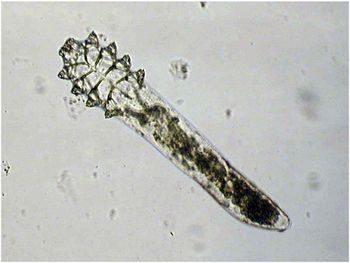Demodex folliculorum
Introduction
Demodex folliculorum are commensal mites that live in human hair follicles. D. folliculorum and D. Brevis are the only species in the Demodex genus that are found on humans, and are both referred to as “eyelash mites”. While D. brevis inhabit the sebaceous glands of hair follicles, D. folliculorum inhabits hair follicles themselves, particularly of eyelashes and eyebrows. Infants will acquire D. folliculorum shortly after birth from contact with other human hosts, however the lack of sebum production in young children prevents D. folliculorum from colonizing efficiently. As humans reach adulthood and continue to age, the infestation of D. folliculorum increases. The elderly and those suffering from immunodeficiency are particularly vulnerable to severe infestation and health risks posed by D. folliculorum including blepharitis.
[1].
Select a topic about genetics or evolution in a specific organism or ecosystem.
The topic must include one section about microbes (bacteria, viruses, fungi, or protists). This is easy because all organisms and ecosystems have microbes.
Compose a title for your page.
Type your exact title in the Search window, then press Go. The MicrobeWiki will invite you to create a new page with this title.
Open the BIOL 116 Class 2019 template page in "edit."
Copy ALL the text from the edit window.
Then go to YOUR OWN page; edit tab. PASTE into your own page, and edit.

At right is a sample image insertion. It works for any image uploaded anywhere to MicrobeWiki. The insertion code consists of:
Double brackets: [[
Filename: PHIL_1181_lores.jpg
Thumbnail status: |thumb|
Pixel size: |300px|
Placement on page: |right|
Legend/credit: Electron micrograph of the Ebola Zaire virus. This was the first photo ever taken of the virus, on 10/13/1976. By Dr. F.A. Murphy, now at U.C. Davis, then at the CDC.
Closed double brackets: ]]
Other examples:
Bold
Italic
Subscript: H2O
Superscript: Fe3+
Section 1 Genetics
The morphology of D. folliculorum shares many similarities to that of D. brevis. Adult D.folliculorum range from 0.3-0.4 mm in length and are composed of two fused body segments. Both segments are covered in scales and assist in anchoring to the hair follicle. The anterior segment has eight short legs attached that allow movement of 8-16 mm/h. Also on the anterior segment is the pin-like mouth that is specialized for eating sebum, skin cells, and hormones. The posterior segment contains a genital opening in both sexes. Rounder and shorter female mites mate with males on the opening of the hair follicle and undergo internal fertilization. Females lay their eggs inside the hair follicle, which hatch into six-legged larvae after 3-4 days and reach adulthood in 7 days. The full lifespan of D. folliculorum stretches over several weeks.
D. folliculorum belongs to the Acariformes superorder, the Trombidiformes order, and the Eleutherengonides supercohort of mites. Estimates of the divergence of D. folliculorum and D. brevis range from 87-173 million of years ago. The mitochondrial genome of D. folliculorum is 14,150 base pairs long and on average 71% made up of AT-pairs. The genome includes thirteen protein-encoding genes, two rRNA genes, and twenty-two tRNA genes. Its Genbank accession number is KM114226.
The D. folliculorum genome is nearly the same size as that of D. brevis (14,240 bp) and within the average range of other Acariformes. A likely explanation is that mites in this superorder face similar selection pressures that favor a compact genome for easier replication. The high amount of AT-pairs also improves metabolic efficiency as it requires less H-bonds to be broken in the formation of a replication fork. D. folliculorum shares the same number of protein-encoding, rRNA, and tRNA genes as all other Acariformes; however, their unique arrangement is only shared by D. brevis. D. folliculorum possesses several other recognizable traits of Acariformes, such as the readiness of movement of tRNA genes and the truncated form of these genes. It is believed that D. brevis and D. folliculorum inherited the same tRNA structures from a common ancestor as the average sizes of their tRNA genes (53.5 bp in D. brevis and 53.3 in D. folliculorum) are very close. Truncated tRNA genes found in both species also share their lack of T-arms and D-arms. Due to the divergence of D. brevis and D. folliculorum occurring many millions of years ago, scientists believe that selection pressure is maintaining these truncated genes. It possible they perform a novel function or can be repaired in some way.
The evolutionary history of D. folliculorum is closely intertwined with their host species: humans. A study of human hosts from various geographical locations revealed that 27% of the D. folliculorum genome can be segregated according to the geographic ancestry of their human hosts. Furthermore, 4 separate clades of D. folliculorum have been established which reflect the migration of humans out of Africa. People of African descent hosted the most diverse sample of D. folliculorum while people of Asian or European descent hosted one or two specific clades. People of Latin American descent also hosted diverse D. folliculorum, which can be explained by the African slave trade migrating millions of African people into the continent.
Section 2 Microbiome
Include some current research, with a second image.
Conclusion
Overall text length should be at least 1,000 words (before counting references), with at least 2 images. Include at least 5 references under Reference section.
References
Edited by Scarlett Jones, student of Joan Slonczewski for BIOL 116 Information in Living Systems, 2019, Kenyon College.
